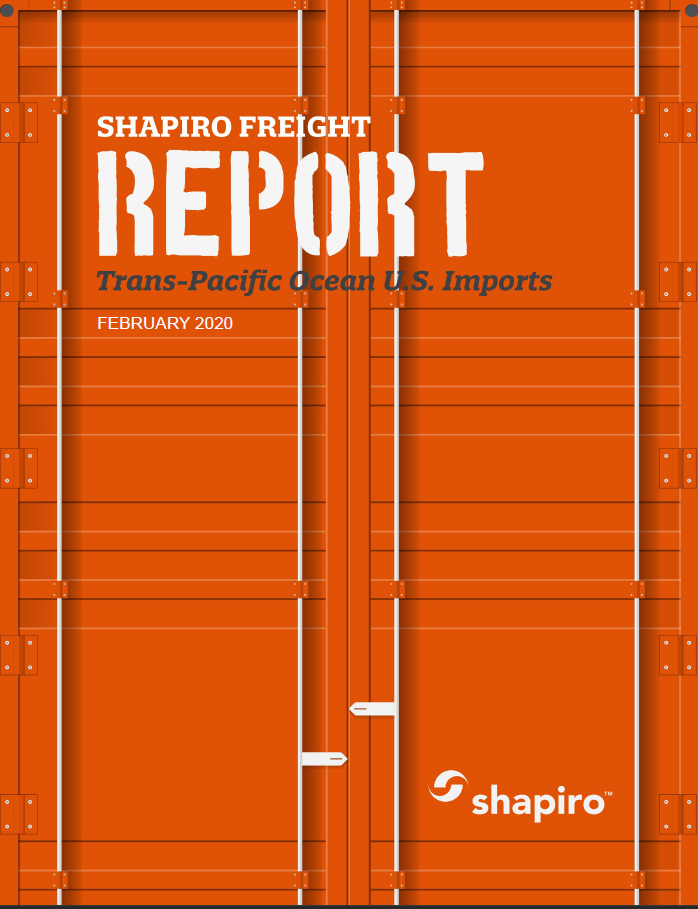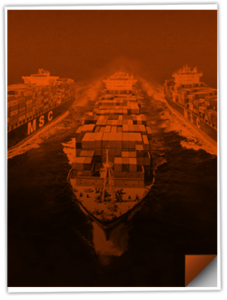Featured Headlines:
The Gifts That Keep on Giving - A Quick Reminder on AD/CVD
DHS Publishes Report Targeting Counterfeit and Pirated Goods
New Weight Regulation Instituted in New York
FMC Announces Proposed Rule Change to Service Contract Essential Terms
Low Sulfur Fuel Prices Begin to Fall as Chaos of IMO 2020 Eases
Reefer Cargo Surcharges Imminent with Shutdown of Asian Ports
The Port of Wilmington Expansion Project Expected to be Ready in March
Legislation Continues to Target Independent Contractors
South African Airways Enters Bankruptcy Protection
The Gifts That Keep on Giving - A Quick Reminder on AD/CVD
For some importers, antidumping and countervailing duties (AD/CVD) can feel like the gifts that keep on giving – but not in a good way.
Did you know that some ADD cases have been active for over 20 years?
Did you also know that you are carrying an open liability until the case is closed and the entry is liquidated?
Let’s take a look at an example.
It’s the summer of 1989, and you had a shipment of roller bearings from China. Back then, the all-country duty rate on this product started at .97% but rose steadily to the current rate of 92.84%.
- Product: roller bearings
- Country: China
- Duty Rate (1989): 97%
- Duty Rate (Current): 84%
Unfortunately, this means that you would have received a bill from U.S. Customs and Border Protection (CBP) every time the duty rate increased incrementally over the past 31 years, and you are still stuck paying ADD in 2020.
As you can see, importing items subject to ADD or CVD can be a financial risk, not just at the time of importation, but for many years to follow. You may want to consider sourcing from a different country, as even if the initial cost is more you may save money in the long run.
Luckily, there are resources available on the International Trade Administration’s (ITA) website that can help guide you through the entire AD/CVD process:
Shapiro is also here to help! Contact [email protected] with any questions.
DHS Publishes Report Targeting Counterfeit and Pirated Goods
On January 24th, the U.S. Department of Homeland Security (DHS) published a report, entitled “Combating Trafficking in Counterfeit and Pirated Goods”, in response to a memorandum that President Trump delivered on the topic on April 3, 2019.
According to the DHS, “the report uses available data, substantial public input, and other information to develop a deeper understanding of how e-commerce platforms, online third-party marketplaces, and other third-party intermediaries facilitate the importation and sale of massive amounts of counterfeit and pirated goods. The report identifies appropriate administrative, statutory, regulatory, and other actions, including enhanced enforcement measures, modernization of legal and liability frameworks, and best practices for private sector stakeholders. These strong actions can be implemented swiftly to substantially reduce trafficking in counterfeit and pirated goods while promoting a safer America.”
In addition to providing recommendations and best practices across the entire U.S. government in due time, DHS will immediately undertake the following actions:
- Ensure Entities with Financial Interests in Imports Bear Responsibility
- Increase Scrutiny of Section 321 Environment
- Suspend and Debar Repeat Offenders; Act Against Non-Compliant International Posts
- Applying Civil Fines, Penalties and Injunctive Actions for Violative Imported Products
- Leverage Advance Electronic Data for Mail Mode
- An Anti-Counterfeiting Consortium to identify Online Nefarious Actors (ACTION) Plan
- Analyze Enforcement Resources
- Create Modernized E-Commerce Enforcement Framework
- Assess Contributory Trademark Infringement Liability for Platforms
- Re-Examine the Legal Framework Surrounding Non-Resident Importers
- Establish a National Consumer Awareness Campaign
Want to learn more? Click here to view the complete report.
New Weight Regulation Instituted in New York
On January 31st, 2020, the Mayor of New York, Bill de Blasio, signed an executive order requiring the New York Police Department (NYPD) to increase truck enforcement on the Brooklyn-Queens Expressway (BQE) effective February 3rd.
Per the executive order, the NYPD will have the ability to issue fines of up to $7000 to any trucker weighing more than 80,000 pounds on the BQE, however city and state permit limits go up to 120,000 pounds.
Built in the 1940s, the BQE was originally intended to handle 47,000 vehicles a day. However, it has instead become an essential daily route for more than 153,000 vehicles, including some 15,000 trucks.
In his executive order, de Blasio explained that “outside consultants hired by the New York City Department of Transportation concluded in 2016 that if the (BQE) is not reconstructed by 2026, weight restrictions may need to be added to the structure, including diverting all truck traffic to local roads.”
These new restrictions could potentially cause issues for any Beneficial Cargo Owners (BCOs) moving overweight cargo in and out of New York City. As a result, BCOs need to work with their logistics providers to evaluate whether any of their shipments could be affected by this new law; and what they need to do to avoid any overweight (OW) penalties. In some instances, shippers may need to consider alternative routes or load weight reductions.
Please reach out to our Transportation team today for assistance in determining the best route for your cargo around NYC!
FMC Announces Proposed Rule Change to Service Contract Essential Terms
Earlier this month, the U.S. Federal Maritime Commission (FMC) announced a proposed change to the Shipping Act that would eliminate a requirement for carriers to publish the essential terms of their service contracts with shippers.
Currently, ocean carriers must provide essential terms to the FMC when filing service contracts, which include:
- Origin and destination port ranges
- Commodities involved
- Minimum volumes
- Duration of the service contract
FMC’s proposal adopts the principles established in 2018 by the World Shipping Council (WSC) under Petition P3-18, which declared that the publication of essential terms no longer serves a purpose in today’s competitive shipping landscape.
Petition P3-18 also called to remove the confidential service contract filing requirement of the Shipping Act, but the commission rejected this section. In the petition, the WSC argued that an exemption to the service contract filing would have no effect on the container shipping market and would not alter competition.
Various organizations wrote to the FMC in support of the full petition to no avail, as the FMC ultimately decided not to move forward with the removal of the service contract filing requirement.
The WSC believes the requirement slows down the process and doesn’t allow the industry to do business at the speed that the world moves today. Consequently, the WSC will continue to push for these changes and will work with the FMC to remove any other antiquated regulations that may hold back the industry.
Public comments regarding the proposal can be submitted to the FMC until April 14th.
Low Sulfur Fuel Prices Begin to Fall as Chaos of IMO 2020 Eases
It appears that the logistical concerns plaguing the shipping community have finally begun to subside in the aftermath of IMO 2020, which in turn has corrected the price of very low sulfur fuel oil (VLSFO).
When IMO 2020 went into effect on January 1st, the industry braced for ensuing chaos to unfold, causing the price of low sulfur fuel to skyrocket in the time directly after implementation. However, such turmoil has yet to come to fruition, and in the absence of such concern, VLSFO prices have begun to plummet.
With IMO 2020, ships were left with two options:
- Begin burning low-sulfur fuel; or
- Install emissions-cleaning scrubbers and continue to burn high-sulfur fuel
The hike in low sulfur fuel prices was driven by last minute buyers, as shippers procrastinated and waited until the last minute to purchase fuel, ultimately causing a spike in the demand and rapid increase in price.
In contrast, the decrease in prices comes after the realization that there are in fact adequate amounts of low sulfur fuel available, which should help to maintain a lower price point. However, if the amount of fuel available were to decrease, any rise in demand would trigger a price spike (again).
Price Gap Between Low Sulfur and High Sulfur Fuel Shrinks
Interestingly, the price gap between low sulfur fuel (LSFO) and high sulfur fuel (HSFO) has also been shrinking.
Despite the narrowing spread between the two, however, the outlook for shippers is still bleak, as they struggle to keep up with higher fuel costs, as well as passing costs off to customers.
The other alternative would be to install scrubbers and continue burning HSFO. The problem with this option is the extremely costly price tag. It also gives carriers a long investment payback period, ranging from six to eighteen months, which doesn’t allow shippers to capitalize on the lower priced HSFO.
Recently, the Chinese government has approved a tax waiver on exports of low sulfur fuel, which is expected to further decrease the price in the market as supply increases.
IMO 2020 has certainly changed the market but hasn’t had a calamitous effect…yet. While VLSFO prices have begun to drop, the true test will arrive this Spring, when demand will soar, and the supply of fuel will lessen.
Reefer Cargo Surcharges Imminent with Shutdown of Asian Ports
The deadly coronavirus has limited port access to parts of Southeast Asia, especially China, for weeks now. The restrictions have resulted in reefer cargo needing to be stored at alternate ports, as the immobile cargo occupies storage space.
Because these ports do not have the plug-in capacity to hold as much reefer cargo as is being shipped, the price of storage has skyrocketed. As a result, carriers are now passing higher costs onto customers in the form of plug-in surcharges and monitoring fees.
Although the surcharge has no set price, most carriers are charging between $1000 – $2000; and in many cases, it is being applied without prior notice to the customer.
Some carriers have resorted to invoking clauses in their bill of lading, which allow the carrier to leave the goods at any port it deems “safe and convenient”.
At this time, carriers are attempting to arrange for reefer containers to get to the shippers’ desired port. However, some, such as ONE, encourage customers to plan for alternatives, especially for time sensitive products like fresh produce.
Given the drastic rise in Chinese reefer cargo in recent years, cargo insurers anticipate shippers will file substantial insurance claims in wake of the spoiled goods.
With the coronavirus expected to calm this spring, normal operations in China should resume at the beginning of March. Once operations return to normal, reefer cargo is expected to be able to enter and exit Asian ports more freely, decreasing the demand for reefer cargo storage space. The lowered demand will allow prices to return to normal, resulting in the removal of the reefer cargo surcharges.
The Port of Wilmington Expansion Project Expected to be Ready in March
Located in North Carolina, the Port of Wilmington is expected to be able to start handling 14,000 TEU vessels in March, once the renovation to raise its transmission lines is complete.
As part of the renovation, the port’s turning basis has also been widened. The new width will allow the port to handle vessels carrying up to 14,000 TEUs, which is a marked increase from the previous max of 12,000 TEUs. The expansion will allow the Port of Wilmington to take in some of the largest vessels on the East Coast, as well as better accommodate the demands of customers.
Although similar ports experienced growth throughout 2019, Wilmington experienced a decrease in overall container volume last year, signaling the need for change.
In addition to widening the turning point and lifting transmission lines, the port is also expanding its refrigerated container yard; however, that isn’t expected to be completed until April.
The next stages of the expansion will include an upgrade to the container gate complex and the implementation of a new operating system.
Altogether, the $200 million infrastructure expansion project is expected to double the port’s capacity from 600,000 TEUs to 1.2 million TEUs annually.
While these changes are expected to allow the port to operate at peak productivity, there are still a few issues that remain. The first of which being that larger vessels cannot enter the port during low tide due to the shallow water in the harbor. Although the port is currently in the process of deepening its harbor from 42 to 47 feet, it’s not certain whether this will be deep enough to alleviate the issue, as most large ships tend to require a harbor depth of at least 50 feet to comfortably navigate.
Legislation Continues to Target Independent Contractors
Last month, a federal judge granted a preliminary injunction to the California Trucking Association for the controversial AB5 bill that would force trucking companies to reclassify independent contractors as employees. The ruling specified that state legislation is preempted by federal law.
A similar New Jersey legislation, S4204, stalled as it failed to come to a vote in the last legislative session. However, it has already been reintroduced as S863 for the current session, which began on January 14th.
These bills require companies to utilize a three-pronged ABC test to define a worker’s role as an independent contractor or employee. The trucking community has been vocal about their opposition since it would not support the existing owner-operator model. Capacity concerns and driver autonomy have been among the cited issues.
This month, another bill targeting independent contractors, referred to as HR 2474, reached the U.S. House of Representatives. On February 6th, the House voted 224 to 194 in support of the bill. However, the bill is not expected to pass in the Senate due to its Republican majority.
Though its unlikely to pass, speculation continues among industry professionals as they attempt to predict how the federal law would govern the state. According to a statement from the JOC, New Jersey employment and labor attorney, Andrew S. Berns, asserted that the latest amendment to the bill would not supersede state laws.
South African Airways Enters Bankruptcy Protection
Recently, South African Airways, a state-owned airline based in Johannesburg, entered bankruptcy protection following a several-years long struggle with profitability.
In an effort to prevent a total collapse, the South African government placed the company under bankruptcy protection in December 2019. As part of the voluntary business rescue, South African Airways will receive more than $136 million from existing lenders at the start of the bailout. It will then receive another $136 million installment from the country’s national treasury at a later point down the road.
In January, the company announced significant operational scale backs, which included the stoppage of all domestic offerings – except those to Cape Town and Johannesburg – in addition to cutting service to 9 international destinations.
Unfortunately, the most recent reports indicate the need for further cuts in order to secure the funding required to remain in business. As a result, the airline’s employees in Durban were notified earlier this month that the route would be closing and that they will be laid off beginning March 1st. The list of employees being laid off is expected to continue to rise as domestic flights are halted.
Additionally, insiders disclosed the likelihood that Johannesburg (and its employees) will soon be cut off from service, as part of their effort to minimize costs.
As of the date of this article’s publication, the airline’s New York and Washington-Dulles services are still operational.
Shapiro News
As previously featured in Shap Talk, Shapiro has been sharing with you the names of employees who have been recognized for their exceptional efforts and contributions to our Company. At Shapiro, we continually work to develop, challenge, and inspire all of our employees to grow individually and with the Company.
This month, we would like to recognize Dhenise Oliveira, Senior Import Analyst.
Dhenise is an industry veteran with over 20 years’ experience. She comes in every day with a positive attitude and a smile. She is a team player who never refuses help to anyone in need. Dhenise figures out how to get the job done, no matter what the challenge. Congratulations, Dhenise!
We encourage you to provide us with employee feedback! Please email us at [email protected].
Shapiro Freight Report
This high-level, monthly review of the U.S. import freight market provides key insights into the tumultuous world of international shipping. From carrier alliances to labor strikes, Shapiro covers the pertinent information logistics managers need to know. Check back monthly to ensure you don’t miss key industry insights!
Year of the Transpacific Ratatouille
PREP:
What is real ratatouille (besides a movie starring a rat named Remy)?
Ratatouille is a French stew made with many disparate ingredients. Typically, it includes eggplant, zucchini, yellow squash, fresh basil, dried oregano, and olive oil (among many more potentials).




